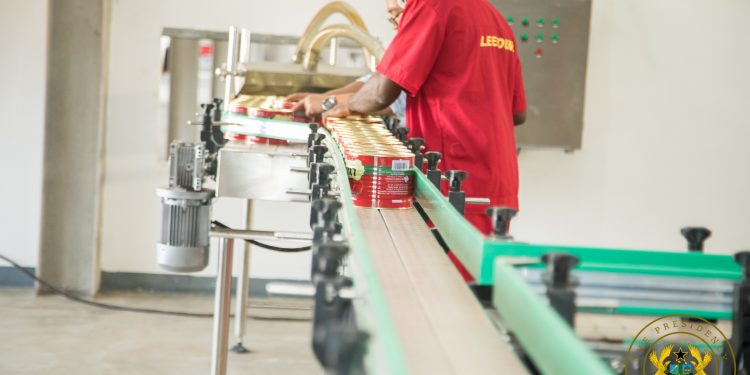Following Ghana’s independence in 1957, the Nkrumah government embarked on an industrialization drive that saw manufacturing’s share of GDP grow from 10% in 1960 to 14% in 1970. This growth resulted in the establishment of a diverse range of industrial enterprises, the most notable of which are the Volta Aluminium Company (Valco) smelter, sawmills and timber processing plants, and cocoa processing plants.
Breweries, cement plants, oil refineries, textile mills, and car assembly plants are only a few examples. However, many of these companies were only able to survive because of government security. In the state sector, shortages of raw materials and spare parts, as well as inadequate maintenance management practices, led to inflation from 1970 to 1977, then a downturn from 1977 to 1982.
The manufacturing sector never completely recovered after that, and output was poor until the 1990s. Underutilization of industrial capacity, which had been an issue since the 1960s, deteriorated significantly in the 1970s, with average capacity utilization in large and medium-scale factories dropping to just 21% in 1982. The supply of foreign exchange for imported machinery increased after the Economic Recovery Programme was introduced.
Following the implementation of the Economic Recovery Programme, the availability of foreign exchange for imported machinery and fuel significantly improved, and capacity utilization gradually increased to around 40% in 1989. Despite this, manufacturing production in 1987 was 35% lower than in 1975 and 26% lower than in 1980.
Ghana’s industry accounts for about 25.3 per cent of the country’s overall GDP. Due to government industrialization policies and commitments, Ghana’s industrial output is rising at a 7.8% annual pace, making it one of the fastest-growing in the world.
His Excellency the President of the Republic, H.E Nana Addo Dankwa Akufo-Addo government reignited the passion to drive industrialization by introducing their flagship industrialization programme called One-District, One-Factory (1D1F). The mission of the One-District, One-Factory programme is to identify and create business opportunities in the districts, harnessing the strengths and resources of the localities in an efficient technology and demand-driven value chain. While previous attempts at rural economic revitalization in Ghana had focused mainly on the provision of physical infrastructural facilities, the 1D1F programme focuses on the promotion of commercially viable business development initiatives, to generate sustainable and accelerated economic development in peri-urban and rural communities.
“Those who do not learn from history are doomed to repeat it” – George Santayana
In as much as these industrialization programmes are vital in the overall economic transformation and viability of the country, we need to go back to what led to the collapse of our industries in the early ’70s to the late ’80s, and the stagnated growth in the 1990s.
One of the key lessons learnt was the non-availability of maintenance and reliability engineering regimes in the management of these national assets. The objective of maintenance and reliability engineering in the life cycle of industrial assets is to maintain the capability of the systems that make up the assets, so these assets can reach their expected performance and quality standards. The purpose of proactive maintenance is to ensure the maximum efficiency and availability of production or manufacturing equipment, utilities and related facilities at optimal cost and under satisfactory conditions of quality, safety and environmental protection.
The inability of asset managers and stakeholders to incorporate maintenance and reliability engineering culture into the management of their assets led to the collapse of these once vibrant industries. The repercussions of this negligence or neglect were enormous. Most of these companies became obsolete and led to job losses. This also led to the over-dependence on import products which we were early on producing in the country. It further deepened the country’s woes by depreciating the value of our local currency since we have become net importers of goods. There is plethora of consequences to list with regards to the collapse of these industries.
Learning from this history it is important to put in the necessary measures to guard factories under the 1D1F from suffering the same fate. To achieve this, the managers and stakeholders of these factories must take into cognizance the following maintenance and reliability engineering processes, tools, and culture to protect and sustain the integrity of these national assets.
Asset Management Planning, Strategy Development, & Performance
An Asset Management Plan (AMP) is a tactical plan for managing an organization’s infrastructure and other assets to deliver an agreed standard of service. Typically, an asset management plan will cover more than a single asset, taking a system approach – especially where several assets are co-dependent and are required to work together to deliver an agreed standard of service. A major use for asset management plan is to communicate information about assets, including particular actions required to provide a defined level of service in the most cost-effective manner. Assets are a part of any enterprise in the public or private sector. Developing and implementing a strategic asset management plan will allow for a detailed understanding of what physical assets are currently held, their value, future value, and costs associated with maintaining them or disposing of them.
Asset Performance Management optimizes the equipment performance and reliability on a daily basis. It helps to identify the current asset’s health and able to provide a long-term view to drive capital planning and understanding the Economic dynamics of the company. Asset Performance Management enables organizations to identify, contain, analyze, manage and optimize risk levels. This improves financial performance indicators such as Profits, Return on net Assets, Efficiency, and Service Factor. APM also improves Plant productivity, Reliability, Availability, Maintainability, and Safety.
Preventive Maintenance Optimization Program
Preventive maintenance is the simplest and most straightforward maintenance strategy to implement. It requires following manufacturer recommendations and establishing a standard maintenance schedule for critical assets and equipment. A world-class maintenance program reflects an organization’s goals and works toward them through planning, implementation, and evaluation. This strategy helps organizations improve quality and output, increase equipment uptime and Overall Equipment Effectiveness (OEE), reduce costs, and safe and stable operating environment.
Maintenance Planning, Scheduling & Strategy
In today’s competitive market, companies are under increasing pressure to produce higher quality goods and services at lower production costs. A key component of the overall cost of manufacturing is maintenance and the key role of maintenance is to guarantee the maintenance and reliability of the production plant.
The introduction of the Computerized Maintenance Management System (CMMS) and Enterprise Resource Planning (ERP) systems makes it easier to plan, schedule and strategize maintenance for operational excellence. The quality of the outputs from these systems is reliant on the quality of the inputs and these can only be assured if we have a robust management system to support maintenance, engineering and operations.
Reliability Centered Maintenance (RCM) Culture
RCM is a methodical and organized process used to choose what must be done to guarantee that any physical resource, framework or process keeps on doing whatever it has been assigned to do. It takes into consideration the primary performance parameters of the assets, possible failure mode and consequence and lastly a suitable failure management policy. The benefits of implementing RCM in company assets management policies bring down expenses by taking out superfluous equipment maintenance costs, decreases the likelihood of sudden machine breakdowns, focuses on maintenance exercises around critical system parts, and improves the overall asset reliability.
PERIODIC PLANT AUDIT
Plant audit intends to identify inherent deficiencies that may adversely affect plant performance, process, operations, reliability program and maintenance activities, including a gap and barrier analysis. Periodic plant audit assessment is very critical as this is one of the best measures of company profit maximization and plant productivity under favourable conditions. The nature of assessment includes Asset Criticality Assessment, Preventive Maintenance Assessment, Reliability Centered Maintenance Assessments, and Maintenance Skills Assessment.
In conclusion, 1D1F must not end with policy implementation just to score political points. The entire economic chain must be maximized. From throughput efficiency, maintenance efficiency, service efficiency, all the way to profit efficiency, and consumer satisfaction must be well thought through. The most critical in the economic chain, maintenance efficiency must be given utmost attention as its role affects every other unit in the chain, hence the need for smart maintenance and reliability programs to achieve policy success.
–
Writer: Abel Sallah, CMRP (Maintenance & Systems Reliability Consultant)
abel.sallah@gmail.com | 0243586818





